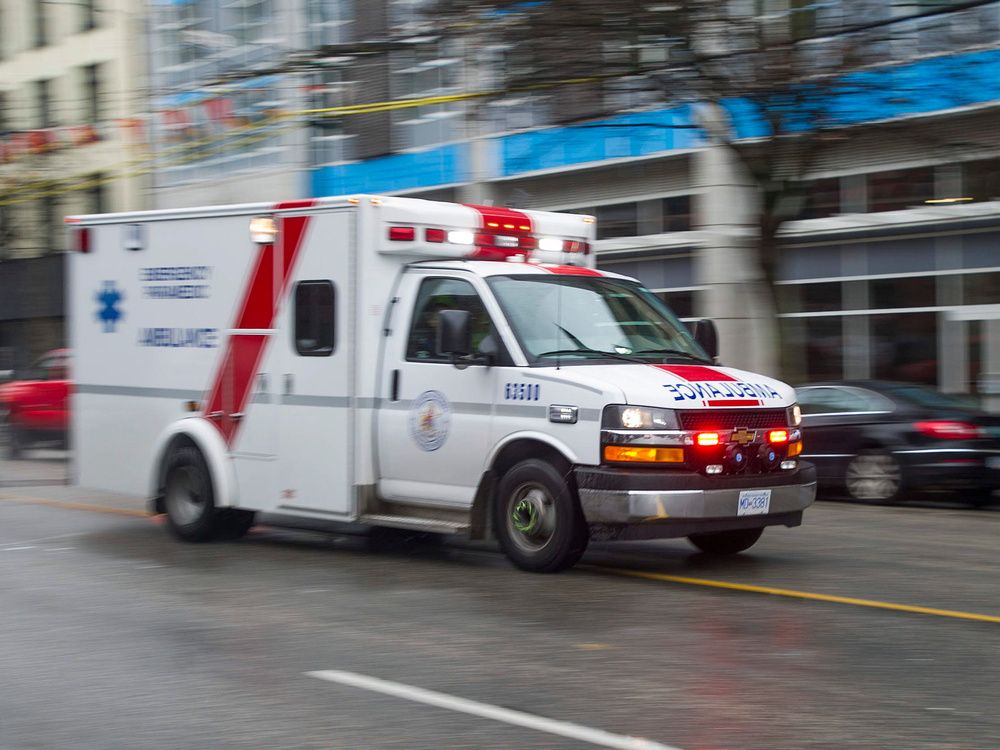
Fewer and fewer calls for ambulances in Metro Vancouver are meeting time targets for life-threatening emergencies like heart attacks or strokes, according to a Postmedia analysis of data provided by B.C. Emergency Health Services .
Provincewide, waiting times for an ambulance increased at the highest rate in Delta, West Vancouver and White Rock. The median response time for life-threatening calls such as cardiac arrests increased by over 40 per cent between 2018 and 2024 in those communities
“Staffing continues to be a big issue for us in the ambulance service,” said Ian Tait, communications director for the Ambulance Paramedics of British Columbia, CUPE Local 873. “So when you have a Friday night going into a long weekend, and if your ambulances are down 10, 20, 30, 40 per cent, you are going to see that in response times quite clearly.”
The median time it takes for ambulances to respond to potentially life-threatening emergencies in 2024 has increased in every Metro Vancouver municipality since 2018. Vancouver, which typically has always met provincial targets, had a median response time of 10 minutes, 41 seconds last year — three minutes longer than 2018.
In life-threatening emergencies like heart attacks, ambulances should arrive in under nine minutes, according to the national benchmark.
While the increasing response times are a concern, they are median times. That means half the calls were faster and half were slower than the numbers provided by BCEHS.
Provincewide, most British Columbians waited longer for paramedics to arrive for urgent calls in 2024 than in 2018. In many communities, those waiting times get longer every year.
“If BCEHS was meeting that nine-minute target, they’d be blaring it from the rooftops,” said Tait. “The reality of it is they’re not meeting it.”
Despite numerous announcements by the province and B.C. Emergency Health Services in 2021 and 2024 , the staff shortage is driving up waiting times, Tait said.
“We’re hundreds of paramedics short,” he said.
Call volumes in Metro Vancouver nearly doubled from 2018 to 2024, according to BCEHS figures.
B.C. Emergency Health Services responded to 607,716 calls in B.C. in 2024 — just over one call every minute of every day and an all-time high, said Bowen Osoko, a BCEHS spokesperson.
Threats to life and other urgent cases made up 38 per cent of calls in 2024.
According to Osoko, the increases were related to a number of factors, including a larger and aging population, increases in chronic and complex health conditions, and the toxic drug crisis.
Tait said there has been an increase in calls classified as “red” in recent years. These calls can range from something as basic as a stomach ache that could signal something more serious to a potentially life-threatening heart problem or drug poisoning.
Response times for the higher-priority “purple” calls, which involve immediately life-threatening cases such as cardiac arrests, he said, remained stable.
Data provided to Postmedia did not separate the two types of urgent calls.
Osoko said in an email that the median response time for purple calls in urban areas was 7 minutes, 38 seconds in 2024. For red calls in urban areas, it was 10 minutes, 34 seconds.
“Despite increasing pressures on the health-care system, overall response times for the most urgent calls have remained similar or improved over the last several years in the province as a whole,” he said.
Both Tait and Osoko pointed to a program BCEHS launched in 2022 that works to reallocate less-critical calls from paramedics to more care-appropriate services like telehealth, transportation to urgent primary care centres or other community resources.
Taite called the change significant.
“They’ve tried to figure out ways to get (patients) different resources so that they could free up more ambulances for the actual emergency,” he said.
Osoko said many communities have increasingly been using other first responders, including firefighters and emergency medical call-takers, to provide support until paramedics arrive.
“It’s important to emphasize that longer call times do not mean someone is left waiting without care,” he said.